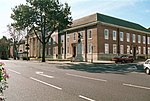Worthing Tabernacle
1895 establishments in EnglandChurches completed in 1908Churches in WorthingGrade II listed churches in West SussexReligious organizations established in 1895 ... and 2 more
Romanesque Revival church buildings in EnglandWorthing

Worthing Tabernacle is an independent Evangelical Christian church in the town and borough of Worthing, one of seven local government districts in the English county of West Sussex. The present building, with its distinctive pale stone exterior and large rose window, dates from 1908, but the church was founded in 1895 in a chapel built much earlier in the 19th century during a period when the new seaside resort's population was growing rapidly. In its present form, the church is affiliated with the Fellowship of Independent Evangelical Churches. English Heritage has listed the building at Grade II for its architectural and historical importance.
Excerpt from the Wikipedia article Worthing Tabernacle (License: CC BY-SA 3.0, Authors, Images).Worthing Tabernacle
Chapel Road,
Geographical coordinates (GPS) Address External links Nearby Places Show on map
Geographical coordinates (GPS)
| Latitude | Longitude |
|---|---|
| N 50.8148 ° | E -0.3712 ° |
Address
Worthing Tabernacle
Chapel Road 64
BN11 1BN
England, United Kingdom
Open on Google Maps









